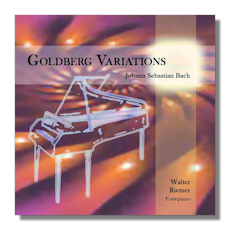
The Internet's Premier Classical Music Source
Related Links
- J.S. Bach Reviews
- Latest Reviews
- More Reviews
-
By Composer
-
Collections
DVD & Blu-ray
Books
Concert Reviews
Articles/Interviews
Software
Audio
Search Amazon
Recommended Links
Site News
 CD Review
CD Review
Johann Sebastian Bach

- Goldberg Variations, BWV 988 (48:58)
- Selections from Two-Part Inventions and Three-Part Sinfonias:
- Invention #4 in D minor, BWV 775 (1:04)
- Invention #8 in F Major, BWV 779 (1:01)
- Invention #9 in F minor, BWV 780 (1:22)
- Invention #13 in A minor, BWV 784 (1:18)
- Sinfonia #2 in C minor, BWV 788 (1:37)
- Sinfonia #6 in E Major, BWV 792 ]1:17)
- Sinfonia #7 in E minor, BWV 793 (1:52)
- Sinfonia #9 in F minor, BWV 795 (2:54)
- Sinfonia #13 in A minor, BWV 799 (1:35)
- Sinfonia #15 in B minor, BWV 801 (1:15)
Walter Riemer, fortepiano
Recorded at the Schloss Niederfellabrunn, Austria,
April-May 2007
NF-Audio (no catalog number) 66:44
A unique and outstanding release! It is rare that I can say this about a recording, but this newly minted one played by Austrian keyboardist Walter Riemer fully deserves the designation.
What makes this release unique is Riemer's use of a fortepiano, in this instance a 1995 reproduction of an original built by Andreas Stein in Augsburg, 1773. Riemer claims that his recording is the first-ever of the Goldbergs on a fortepiano, and I have to agree as I have not heard of another recording of the work on fortepiano and my inquiries of a few other Bach keyboard enthusiasts yielded no citation of other recordings on fortepiano. As for the sound of Riemer's fortepiano, it is wonderful with abundant heft, depth and clarity. Those of you who think of the fortepiano as sounding tinny and weak need to hear this particular instrument; your doubts will be quickly erased.
Another enticing feature of the disc is that Riemer uses the Bach/Lehman tuning system (1722). About four years ago, the musicologist and early music keyboard artist Bradley Lehman determined that the diagram of loops at the top of the title page of Bach's Well-Tempered Clavier Book 1 (1722) revealed Bach's preferred tuning system. After deciphering the diagram, Lehman found that this tuning system resulted in a more agreeable sound throughout the tonalities than in any other tuning system applied to Bach's music. From my own listening experiences, I think it's fair to say that this newly discovered temperament offers a more cantabile and lyrical presentation than other temperaments. Further, the use of of the new temperament is increasing with time. Well-known keyboardists including Peter Watchorn and Richard Egarr are using it exclusively with Bach's works, and it wouldn't surprise me if the new temperament becomes the standard in a few years.
On to the performances, and they are stunning interpretations with a high degree of technical aplomb. Riemer's lively rhythmic bounce is delightful, and he does an exceptional job of clarifying and balancing musical lines. In addition there are two special features that really put these performances "over the top", one of them quite compelling and the other thoroughly captivating.
To explain the compelling feature, I should offer a few comments about the architecture of the Goldberg Variations. Both the opening Aria and each of the variations are in two sections. Where Riemer differs from most other performers of the work is that his second sections are often just a bit quicker than the first sections and also possess greater tension and urgency. This creates a "mini-climax" effect that is invigorating and adds to the sweep of the music.
Dance rhythms can be captivating as evidenced by Bach's six-packs of French Suites, English Suites and Partitas. Although the Goldbergs are not made up of dance movements per se, there are abundant opportunites to highlight dance patterns and Walter Riemer makes the most of those opportunities. Often while listening to his interpretation, I am unable to refrain from dancing away the hour. Riemer offers rhythms with great elasticity and bounce that make for a delicious listening experience.
As for the selections from Bach's Inventions and Sinfonias, I only wish that Riemer had played the entire work for he gives the selections the same interpretive profile as the Goldberg Variations.
Any reservations? Not from my end, but I should mention a couple of items that some readers might find troublesome. First, Riemer plays fewer than half the repeats, so readers who insist on all repeats being performed are duly advised. Second, the faster variations are played much slower than the norm; however, Riemer's strong articulation and textural variety results in very interesting interpretations.
Don's Conclusions: Excepting those who are allergic to the fortepiano, Walter Riemer's recording is a must-have for Bach keyboard enthusiasts. Just go to the NF-Audio website http://niederfellabrunn.at/Akt/CD-Label.php to obtain your own copy of this irresistible and unique disc.
Copyright © 2008, Don Satz












